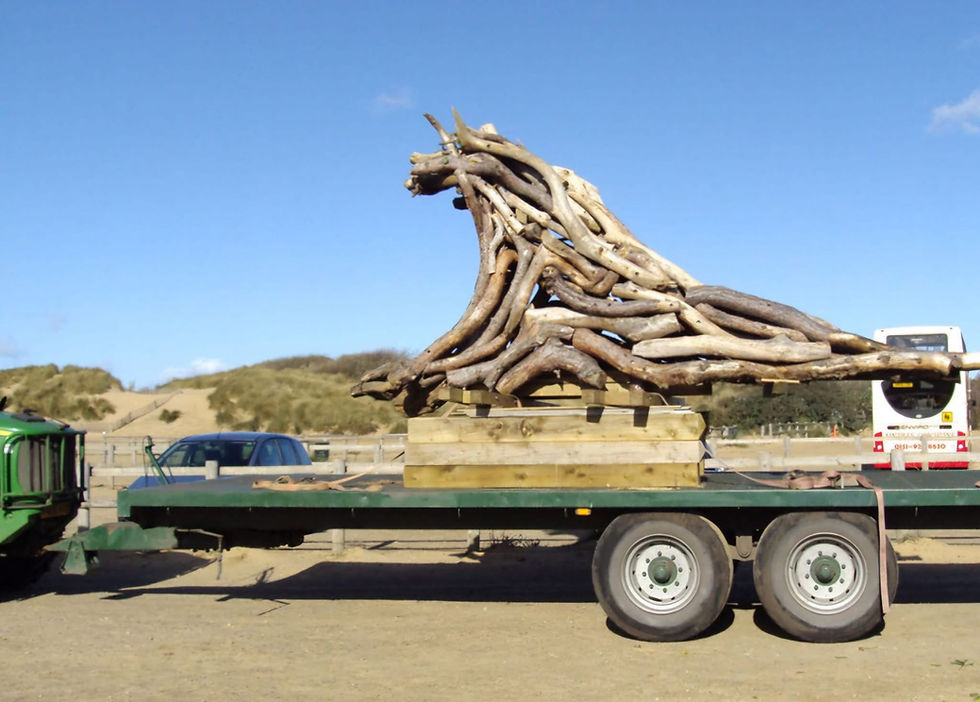Formby's Footprints Walk
- Formby Bubble

- Mar 15, 2016
- 3 min read

The National Trust at Formby run a project to discover the fascinating story of Formby's prehistoric footprints, found in the mud on Formby Point and search for traces on the foreshore with one of their archaeology experts.
Our beach is a stretch of unspoilt coastline where erosion of the sand has revealed exciting glimpses into the past. Most famous are the footprints that date back to the late Neolithic era (7,000 years ago).
Also discovered are many other remains that suggest a rural, industrial and maritime past. Yet none of these discoveries had been studied in any detail.
Historic Landscape Survey:
The site is of such historical importance, it was decided that further investigation was needed.
In 2006, the Liverpool Museum Field Archaeology Unit was commissioned to produce a Historic Landscape Survey, allowing The National Trust to record and analyse the landscape so that they could understand it better.
The aims of the project were as follows:
Identify and record all visible sites, features and landscape elements of archaeological or historic interest
Develop a chronological framework for the development of the landscape through time
Collect historic maps and documentary evidence
Write the story of Formby, from the prehistoric to the present day
Produce a report to act as a useful tool for property management
Highlight any apparent threats to the archaeological resource
The survey revealed Formby’s fascinating, yet often hidden, past, including: marram grass and the stabilisation of the dunes, rabbit warrens, asparagus cultivation, shipping and shipwrecks, fishing and cockling, smuggling, landclaim and tree planting.
The earliest evidence
Formby Point is part of the Sefton Coast Site of Special Scientific Interest, one of the largest complexes of sand flats and dunes in the UK. The origin of the dunes along Sefton’s coast can probably be traced back 8,500 years.
By 5000 BC, rising sea-levels had cut Britain off from the European mainland. Over the next several thousand years, the Sefton coast moved backwards and forwards, sometimes further to the west, at other times reaching further inland than today.
Footprints out of time
By about 2500 BC, the archaeological evidence suggests that people were making many repeated visits to the area, rather than settling permanently.
We can form a picture of this lifestyle from prehistoric human and wild animal footprints revealed in beach sediments at Formby Point.
There are currently more than 220 identified trails of human footprints. The animal prints include aurochs (large wild cattle), deer, wolf, and wading birds.
Stories from the mud
By studying the footprints, with advice from the British Museum, we can understand the physical characteristics and behaviour of the people who made them. For example:
The average male height was 1.66m and average female height was 1.45m
Most of the prints were made by children with a smaller number of women and relatively few adult males
Where males are present, they tend to occur in the same areas as red deer and have different stride patterns from the women and children. This suggests that the two groups were involved in different activities.
The women and children might have been on the mudflats collecting shells or looking for nesting birds
The adult male prints may reflect hunting or herding activities
Radiocarbon dates from roots and animal bones tell us that the footprints were created between 5100 and 3400 years ago, from the late Neolithic to the middle Bronze Age, in intertidal muds
The footprints at Formby are very, very special and The National Trust has employed a huge range of archaeological expertise and techniques to bring the story they tell alive.
The people who made the footprints were doing everyday tasks and cannot have known the importance of the tracks they left behind in the mud. Who knows what people in 4,000 years from now will make of the products we will leave behind us?
The next few Formby's Footprints Walk will be between 1:00pm and 4:00pm on the following dates:
12 May 2016
28 June 2016
12 Sept 2016
11 Oct 2016
Booking is essential for these events, if you would like to take part please follow the link:







.jpg)























.jpg)


Comments